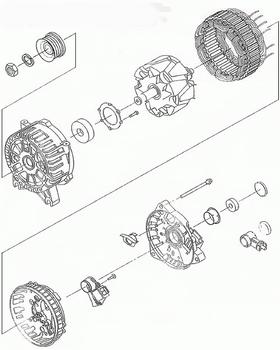How An Alternator Works?
Alternator
Working Of Your Vehicles Alternator
Maintenance
To ensure that your alternator lasts as long as possible there are several things you can do. Be sure all battery connections are tight and both terminals are clean. This should be inspected periodically regardless of when the battery was changed as even new batteries can have problems and be defective.
Common Problems
- Alternator will overheat due to extreme usage causing a failure.
- Poor battery condition can cause alternator failure.
- Weak alternator can cause the battery to slowly drain down
- Once jump started a severely discharged battery can cause the alternator to overload and fail internally. If this occurs replace or charge the battery before replacing the alternator.
- The serpentine belt connected to the alternator must be in good shape to operate properly.
- Clean battery terminals regularly
Article explains how an automotive alternator works.
Alternator operation explanation exploded images and description. A battery is needed to power the operating system of your car. Once the engine is running the alternator is driven by a serpentine belt that charges the battery. While in operation the alternator creates electricity, about 13.6 to 14.6 volts, and recharges the battery to its original state of charge. When a vehicle is running the alternator is busy creating electricity to provide the engine and the car accessories with needed power. When the car is not running and the battery is discharged as electrical components such as alarms or other memory retaining items may still operate. Typically, these components are designed to operate properly at 12 volts, if the system voltage is low it can cause erratic symptoms.

Alternator Exploded View
The alternator works on the principle of electromagnetism. This means by turning the magnetic armature inside the alternator which has electrified coils in the housing it will produce AC voltage. Using a series of diodes this AC voltage is converted to DC voltage which the cars electrical system is designed for. The armature is supported by two roller bearings on either end of the alternator housing. The voltage is transferred to terminals at the rear of the housing using a brush set. Once these brushes wear out the alternator stops charging. A voltage regulator is used to control the voltage when the alternator is spun at higher RPM's. If the voltage regulator fails it can overcharge the battery causing a battery failure.
Additional problems can occur if the alternator is overcharging the electrical system. Some symptoms of overcharging include a swollen or seeping battery, both headlight bulbs failing at the same time, and other random electrical component problems. To perform an alternator system check please visit - Alternator Testing
The most common alternator problem is "undercharging." This condition is often accompanied by symptoms such as a low state of charge on the battery, poor or erratic performance from electrical components and dim headlights and other lighting systems. The first symptom of an undercharging alternator is a slow cranking engine. The next symptom is a "machine gun" sound when the engine is cranked as the system voltage drops below normal operating levels. In order to correct this problem a replacement alternator must be installed after the battery has been replaced or re-charged.

Alternator Exploded View
Comments
Post a Comment